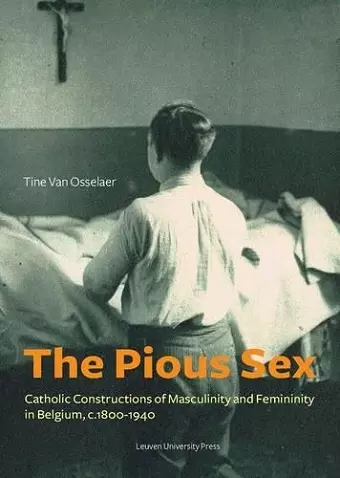The Pious Sex
Catholic Constructions of Masculinity and Femininity in Belgium, c. 1800–1940
Format:Paperback
Publisher:Leuven University Press
Published:10th Dec '13
Currently unavailable, our supplier has not provided us a restock date

The construction of gender in Belgian Catholicism
Although women were called the ‘pious sex’ much earlier, it was during the nineteenth century, when the differences between men and women were being made more explicit, that an intense bond between women and religion was developed. Religiosity was thought to be a ‘natural’ part of femininity and turned religious masculinity into an oddity. This clear-cut gender ideology, however, remains an ideology (prescribed and contested) that needs to be put in the perspective of its context of origin, the bourgeois milieu. How were these gender identities constructed and by whom?
With this volume Van Osselaer seeks to clarify how the gender differentiation was created among Belgian Catholics. She brings to light the extent to which religiosity was inscribed in these constructions and how religious teachings contributed to it. It is clear that the limitations of the ‘feminization’ thesis, a master narrative that has strongly contributed to the introduction of women in religious history, have gradually become more visible. Documenting pastoral care, the devotion to the Sacred Heart of Jesus and Catholic Action, The Pious Sex offers critical commentaries on the master narratives, suggesting that even men could belong to a ‘pious sex’.
This publication is GPRC-labeled (Guaranteed Peer-Reviewed Content).
Tine Van Osselaer’s meticulously researched The Pious Sex constitutes the most recent comprehensive product of the first generation of scholars that thoroughly developed the study of gender, and specifically masculinity, in the modern history of the Low Countries.Stefan Meysman, BMGN - Low Countries Historical Review. 132, 2017
* BMGN - Low Countries Historical Review *Throughout the book, Van Osselaer insists on this dual view, showing that the Pious Sex of the title could be defined as both male and female throughout the nineteenth and early-twentieth centuries in Catholic Belgium. Her analysis of several Catholic initiatives impressing the laity with carefully designed images of “devout” masculine and feminine identities shows that, although the relation between men and women within Belgian Catholic circles was highly dichotomous and hierarchical, and although women’s roles within these organizations changed substantially throughout the modern period, these changes cannot be qualified as a process of feminization, but rather as one of increasing differentiation. Whereas the introduction offers a sharply drawn theoretical critique of the feminization narrative based mainly on current debates in gender studies, the
empirical chapters show a wide array of roles and models held up to laymen, laywomen, and children.
Josephine Hoegaerts, Catholic University of Leuven, The Catholic Historical Review 2015, vol. 101, no. 2
Van Osselaer's sources are so abundant and voluminous (the book's materials are in Flemish, French, German and English) and she reads them so well, that many fresh, new insights surface. [...] The chapters express an abiding curiosity about the centrality of femininity and masculinity in European Catholicism, and a willingness to read carefully and think deeply about ideas different from one's own. So, not only for the richness of her data, but also as an exemplum of a scholarly ideal, The Pious Sex deserves considerable praise.
Brenna Moore, Fordham University, USA, European History Quarterly, Vol. 45 No. 1
Van Osselaer heeft een helder gestructureerd boek geschreven. Door de structuur steeds duidelijk aan te geven neemt zij de lezer mee aan de hand. Dit schept overzicht, al haalt het soms ook een deel van de spanning weg. Van Osselaer heeft voortdurend oog voor de bredere historische ontwikkelingen en ruimere context waarin haar empirische materiaal te begrijpen valt. Haar proefschrift bevat een uitgebreide geschiedenis van de religieuze bewegingen die zij beschrijft, en maatschappelijke ontwikkelingen krijgen een centrale plek in haar betoog. Van Osselaers belangrijkste bijdrage is echter haar scherpzinnige en genuanceerde genderanalyse van het gevarieerde bronnenmateriaal. Zij heeft een indrukwekkende hoeveelheid bronnen bestudeerd en plaatst haar analyse in de context van de internationale secundaire literatuur. Het boek eindigt met een oproep om binnen religiegeschiedenis meer aandacht te besteden aan de historische en geografische veranderlijkheid van genderconstructies. Van Osselaers studie laat het belang van een dergelijke benadering zien.
Saskia Bultman, Radboud Universiteit Nijmegen, Tijdschrift voor Geschiedenis, Volume 127, Number 4, November 2014, pp. 728-729(2)
The 'Pious Sex' is a must-read for gender historians, theologians, feminist theorists, religious historians and anyone else who wishes to move beyond the simple stereotypes of 'female piety' to gain deeper insights into the logic and contradictions of Catholic devotion in the 'long' nineteenth century and throughout the 1920s and 1930s.
Mary Heimann, University of Strathclyde, The Innes Review 65.2 (2014): 158-;184
Feuilleter cet ouvrage permet d'apprécier une belle étude historique (beaucoup de sources), qui montre comment s'est construite l'image prescrite d'une féminité par essence voulue "pieuse"... Sondant les stéréotypes, l'auteure, Tine Van Osselaert, finit par suggérer que les hommes aussi, dans le fond, peuvent appartenir au "sexe pieux"...
Blog de Sébastien Fath >>>
ISBN: 9789058679505
Dimensions: unknown
Weight: 907g
272 pages